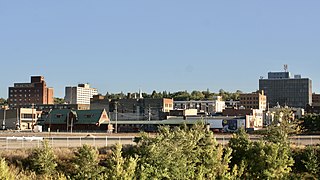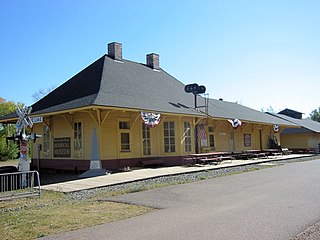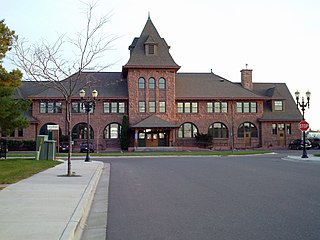
Minot is a city in and the county seat of Ward County, North Dakota, United States, in the state's north-central region. It is most widely known for the Air Force base approximately 15 miles (24 km) north of the city. With a population of 48,377 at the 2020 census, Minot is the state's fourth-most populous city and a trading center for a large part of northern North Dakota, southwestern Manitoba, and southeastern Saskatchewan. Founded in 1886 during the construction of James J. Hill's Great Northern Railway, Minot is also known as "Magic City", commemorating its remarkable growth in size over a short time.

Saint Paul Union Depot is a historic railroad station and intermodal transit hub in the Lowertown neighborhood of the city of Saint Paul, Minnesota, United States. It serves light rail, intercity rail, intercity bus, and local bus services.

The Soo Line Railroad is one of the primary United States railroad subsidiaries for the CPKC Railway, one of six U.S. Class I railroads, controlled through the Soo Line Corporation. Although it is named for the Minneapolis, St. Paul and Sault Ste. Marie Railroad (MStP&SSM), which was commonly known as the Soo Line after the phonetic spelling of Sault, it was formed in 1961 by the consolidation of that company with two other CPKC subsidiaries: The Duluth, South Shore and Atlantic Railway, and the Wisconsin Central Railway. It is also the successor to other Class I railroads, including the Minneapolis, Northfield and Southern Railway and the Chicago, Milwaukee, St. Paul and Pacific Railroad. On the other hand, a large amount of mileage was spun off in 1987 to Wisconsin Central Ltd., now part of the Canadian National Railway. The Soo Line Railroad and the Delaware and Hudson Railway, CPKC's other major subsidiary, presently do business as the Canadian Pacific Railway (CP). Most equipment has been repainted into the CP scheme, but the U.S. Surface Transportation Board groups all of the company's U.S. subsidiaries under the Soo Line name for reporting purposes. The Minneapolis headquarters are in the Canadian Pacific Plaza building, having moved from the nearby Soo Line Building.

Claremont station is a passenger rail and bus station in Claremont, California, United States. It is served by Metrolink's San Bernardino Line which runs from Los Angeles Union Station to San Bernardino–Downtown. The Mission Revival-Spanish Colonial Revival style station is listed on the U.S. National Register of Historic Places as Atchison, Topeka and Santa Fe Railroad Station.

The Fullerton Transportation Center is a passenger rail and bus station located in Fullerton, California, United States.

Fargo Station is a train station in Fargo, North Dakota, United States. It is served by Amtrak's Empire Builder. It is the only railway station in use in the Fargo-Moorhead area and is the third-busiest in North Dakota. The platform, tracks, and station are currently all owned by BNSF Railway. The station is currently located in the former BNSF freight house. The former main station building is now home to Great Northern Bicycle Co.

The Atchison, Topeka and Santa Fe Passenger and Freight Complex is a nationally recognized historic district located in Fort Madison, Iowa, United States. It was listed on the National Register of Historic Places in 1992. At the time of its nomination it contained three resources, all of which are contributing buildings. The buildings were constructed over a 24-year time period, and reflect the styles that were popular when they were built. The facility currently houses a local history museum, and after renovations a portion of it was converted back to a passenger train depot for Amtrak, which opened on December 15, 2021.

The Canaan Union Depot, also known as the Union Depot, is located in Canaan Village, in the town of North Canaan, Connecticut, and is a former union station. It was built in 1872 at the junction of the Housatonic Railroad and the Connecticut Western Railroad which was acquired by the Central New England Railway.

Crosby station is a historic former train station in Crosby, Minnesota, United States. It was established in 1910. It was listed on the National Register of Historic Places in 1980 as the Crosby Railroad Depot for having local significance in the themes of commerce, industry, and transportation. The depot was nominated for being an essential conduit for the arrival of goods and people and the export of iron ore during central Crow Wing County's economic boom years.
Soo Line Depot may refer to the following train stations used by the Soo Line Railroad:

The Chicago, Milwaukee, St. Paul and Pacific Railroad Depot and Lunchroom are two buildings located in Wells, Minnesota, and built by the Chicago, Milwaukee, St. Paul and Pacific Railroad in 1903.

Moose Lake station in Moose Lake, Minnesota, United States, is a depot built in 1907 by the Soo Line Railroad. The building was one of the few buildings that survived the 1918 Cloquet Fire, and it was used to provide shelter for those left homeless in the fires. It was listed on the National Register of Historic Places in 1994 as the Minneapolis, St. Paul, and Sault Ste. Marie Depot.

The Fargo station is a former railway station in Fargo, North Dakota. Built in 1898, it was listed on the National Register of Historic Places in 1975 as the Northern Pacific Railway Depot.

The Midland Continental Railroad Depot in Wimbledon, North Dakota, United States, was built in 1913 to the east of downtown, on 17th Street SE, and was moved to 401 Railway Street in 1920. It was listed on the National Register of Historic Places in 2003.

Downtown Minot is the central business district of Minot, North Dakota, located south of the Souris River in the Souris Valley. Downtown is the site of the first permanent settlement in Minot in 1886. Downtown is home to many of Minot's cultural sites of interest. It is also home to numerous galleries, stores and restaurants. The Minot Riverwalk traverses the downtown.
Samuel L. Bartlett was an American architect who worked in Saint Paul, Minnesota, in the early 1900s. He was appointed to the position of architect with the Great Northern Railway in 1905. Bartlett was tasked to bring to reality the vision of Great Northern President Louis W. Hill for great destination hotels in the newly created Glacier National Park (U.S.). Several of the lodges and stations Bartlett designed for the Great Northern are listed in the National Register of Historic Places.

Outlook station is a railway depot in Outlook in Sheridan County, Montana which was listed on the National Register of Historic Places in 1993 as the Outlook Depot. It has also been known as Soo Line Depot. The listing included two contributing buildings.

The Midland Continental Railroad is a defunct shortline railroad which operated in the U.S. state of North Dakota between 1906 and 1966. The railroad was originally envisioned as a trunk line to run from Winnipeg, Manitoba, Canada to Galveston, Texas. Financing problems led to only two segments totalling 77 miles (124 km) being completed.

The Osceola Depot is a historic railroad station located at 114 Depot Rd. in Osceola, Wisconsin. The station was built in 1916 for the Minneapolis, St. Paul and Sault Ste. Marie Railroad. Later, the line would become a part of the Soo Line Railroad and eventually Canadian National. Today, the depot serves as a part of the Minnesota Transportation Museum as the starting point for a heritage railway.

The Ashland station or Soo Line Depot in Ashland, Wisconsin, United States, was listed on the National Register of Historic Places in 1988. It is a brownstone building and was used by the Wisconsin Central and later by the Soo Line Railroad.




















